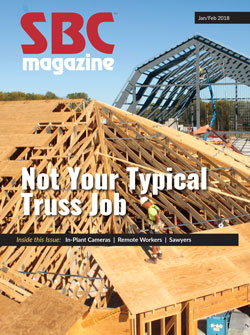President's Message: Talking to Your Saw Should Be Easy
President's Message: Talking to Your Saw Should Be Easy
A friend’s father-in-law recently had surgery for colon cancer. After the surgery, I overheard my friend telling someone they had had to cut off a foot. I was saddened and confused. I later asked my wife, who is a nurse practitioner, why colon cancer would cause a foot to be amputated. The response I got was, “a foot of his colon, you idiot.”
Indeed, many of the problems we face each day can be traced back to poor communication. Misunderstandings over terminology can lead to erroneous conclusions and bad decision making. A language barrier or cultural difference can make a particular approach to management less effective. Unspoken expectations can lead to unexpected and disappointing results.
I’ll give you another example. We recently built a job for a customer and delivered it to lot 21. A few days later, we built another job for the same customer, which was to be delivered to lot 63 in the same subdivision. However, when the driver arrived at lot 63, we discovered that lots 21 and 63 were the same. The problem lay in the fact that “lot 21” was the county’s designation and “lot 63” was the builder’s. No one noticed that the addresses were the same when each request came in. Because the county and the builder were using different terminology, we ended up building the same job twice.
It goes without saying that for everything to work well in your company, you need to ensure everyone communicates clearly. The same is true for the software and equipment we use for component design and production.
We currently invest a lot of capital in our equipment, and the drive toward automation and robotics increases those expenditures. Advances in design, throughput and material optimization software promise significant improvements in production efficiency, but that’s predicated on the software communicating effectively with production equipment.
The bottom line is, for all of this advanced equipment and slick software to reach its maximum potential – the potential we invest in on the front end – it needs to work together. Currently it does not.
I was approached by a few individuals at BCMC about the need for our industry to develop what is called a “unified file output.” I’m not a programmer, so I can’t go into the gritty details of what that is, but in simple terms, it means that every piece of software our industry relies on would output information, a truss configuration for example, in the same format. That way, any piece of equipment could readily access and understand the data to do its job. Not only could your design software communicate clearly with your saws, but individual pieces of equipment could communicate effectively with one another.
A unified file output for our industry would not only improve how our software and equipment collaborate, but also open the door for greater innovation and encourage more companies to develop equipment and software for us to use.
The first step is creating a subcommittee – within the SBCA IT Committee and made up of component manufacturer information technology professionals, software programmers and equipment manufacturers – to develop a recommendation everyone can react to and improve upon. If you’re interested in serving on this subcommittee or nominating someone to serve, please let me know.

